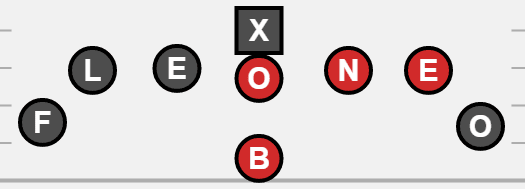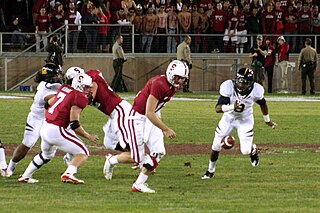"We don't have a playbook. I found that if you have playbooks, they end up on eBay and everywhere else.” Paul Johnson
The main portion of the Flexbone Offense is its Veer concept. For those new to this topic, we look up the knowledge bible -
Wikipedia - again.
"The Veer is an option running play often associated with option offenses in American football, made famous at the collegiate level by Bill Yeoman's Houston Cougars. It is currently run primarily on the high school level, with some usage at the collegiate and the professional level where the Veer's blocking scheme has been modified as part of the Zone Blocking system. The Veer is an effective ball control offense that can help minimize mismatches in a game for a team. However, it can lead to turnovers with pitches and handoff option reads."
Wow! There's a lot of information in this article we need to think about.
Early in my coaching carreer (it started 2000), I was lucky enough to be part of a coaching clinic featuring Bill Yeoman and getting a hand on his Veer T Offense book. One may argue that this might have been a big influence on me, and that I may have become a Spread Option offense guy if this didn't happen to me. In some way you are right, the systematic approach has caught me instantly.
Currently, the veer is used in many different formations. You see it under center as a traditional split-back, I-formation or wishbone offense but it got popular within the spread (shotgun) and pistol offenses recently. The basic idea behind it is probably used more often then ever before.
Wikipedia bullseyes it in saying that it is an effective ball control offense that can help minimize mismatches. This is basically the reason why the Veer exists and why it has its proponents in the NCAA D1 service academies. We will discuss the little thing stated at the end in future articles, just so far, ball security is the most important thing in every offense, the Flexbone and the Veer are no exception.
"The Veer option is generally regarded as a "triple option". It is designed as a four-back attack with one player taking a dive course, one taking a pitch course and another being a lead blocker on the perimeter of the offensive formation. The QB makes reads on defensive players and then distributes the ball according to the defensive reaction to the offense. A typical play proceeds as follows (we will assume that this is an "inside veer" going to the right side out of the split-back formation): the quarterback takes the snap. He then does what is called "opening up": the quarterback goes from his two point stance, facing forward, and takes (in this situation) his opposite side, left foot and pivots ninety degrees on his right foot, extending the ball toward the sideline he is facing. The split-back halfback on the right side, who in this situation is the "dive back", goes forward into the line to where the quarterback is and meets in an area called the "mesh point". This is where the idea of the Veer begins to take shape: the offensive line has left one man unblocked here, most likely a defensive tackle (although it can be a linebacker)."
Translated to the Flexbone terminology:
"... A typical play proceeds as follows (we will assume that this is an inside veer going to the right side out of the Flexbone Ace formation) the quarterbacks takes the snap. ... (a future article will cover the footwork of the quarterback) ... The B-Back, who is the dive back, goes forward into the line to where the quarterback is and meets in an area called the mesh point. ..."
Wikipedia continues:
"This man is being Read by the QB. The defender is being forced to choose between tackling the dive back or the quarterback. The dive back explodes forward, puts his arms around the ball that is being extended, but does not take it. The quarterback, in his open stance, is reading the man being veered to determine whether he will "pull" the ball from the dive back, or let the dive back take the ball and go through the hole. This is where the name of the offense, the veer, comes from. This is just one part of the four-part option. If the quarterback keeps the ball, he attempts to cut up the field with the opposite side halfback, who has been running right towards the dive back's original position. He is the pitch man."
For the Flexbone:
"... If the quarterback keeps the ball, he attempts to cut up the field with the backside A-Back, who has been running right towards the dive backs original position. He is the pitch man."
And the last part:
"He attempts to maintain proper pitch relation to the quarterback, technically a few yards outside the quarterback and moving laterally so that the quarterback may pitch the ball as he goes down the field. This entire action does not take longer than a few seconds. The fourth player in the split-veer would be a wide receiver or tight end. His job, depending on the formation, would be to block the force player who is responsible for the flat to the side they are attacking. The offense relies on the quarterback making the proper reads, and reacting to the read (if he decides to keep the ball), turning up the field and gaining yardage. The dive back must remember to not take the football from the quarterback, rather the quarterback must give it to him. The pitch man must know to maintain proper spacing from the quarterback to ensure that the quarterback can make an effective pitch that can ensure more yardage."
Again, different terminology:
"... The fourth player in the Flexbone Veer would be the playside A-Back. ..."
Not a lot of changeups from the original article as you see. The explanation contains a couple of intriguing phrases that have to be discussed and specified.
First, the footwork for the Quarterback will fill lots of future articles because there are different philosophies out there.
Also the term "mesh point" is a story on its own, we will learn that there exists a "no-mesh mesh". Weird, huh?
Unfortunately the Dive Key, the defensive lineman left unblocked, can do more than just choose who to tackle. This would be too easy for us.
In the last part we need to be way more specific than telling our players to be just a couple yards outisde and that the action just takes a couple seconds.
Wikipedia has more to offer:
"When an offensive system is devised for a team, the coach must take into account his players, so the veer can be applied to several situations. It can be used for undersized players so that double teams and angles can be used to block defenders. It can be used to isolate defenders and create predictable responses to the offenses actions. If a team is very disciplined it can take advantage of an undisciplined defense that can not execute their responsibilities precisely on each snap of the game. The veer relies on precision, execution, and smarts, rather than an advantage in athleticism, to score points. The ability of the QB to identify weakness in defensive alignment is paramount, as the veer can take quick advantage of a defensive misalignment. The veer also can be used with great effect when the offensive line is a strength of the team. Over time, the ability to pass out of the Veer has also been utilized depending on the quarterback's ability to "bounce" into a moving pocket to make short range passes. The most effective methods of passing out of the Veer also places emphasis on the interior linemen's ability to "sell" the defense on a run block scheme. Short yardage or goal line offensive situations are ideal for a Veer option pass play. The receivers that are the best options for a pass play out of the Veer are the first running back through the line who runs a "go" route isolating the frozen safety; the slot receiver who can release quickly from a block to run a skinny "go" route behind the cornerback or a tight end that can release out of his interior block and find an open seam underneath the lone safety. A third component to the Veer that comes with some passing success is the ability to run trick or gadget plays to take advantage of over anxious defensive backs and over pursuing linebackers. Once the ability to pass out of the Veer has proven successful, the countering of the Veer becomes more conventional and the safeties and cornerbacks must respect the pass first before attacking the line of scrimmage."
Key messages can be found in here. It works with undersized players, the team has to be disciplined, it relies on precision, execution and smarts and not on an advantage in athleticism.
RESSOURCES:
-http://en.wikipedia.org/wiki/Veer



.jpg/230px-Fisher_DeBerry_(cropped).jpg)

